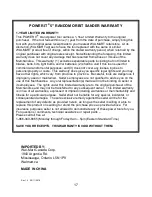
12
CONNECTING THE DUST BOX ASSEMBLY
TO THE SANDER
1.
Slide the dust box connector (1) into the
dust port (2) in the rear of the sander
(Fig. 5).
NOTE:
Make sure the dust box connector
key (3) mates with the dust port key way
(4).
2.
When the dust box connector is pressed
fully into the dust port, turn the dust box
approximately 15° clockwise to lock the
dust bag onto the sander.
CLEANING THE DUST BOX
1.
Remove the dust box assembly from the
dust port by rotating it approximately 15°
counter clockwise and pulling it out of the
dust port.
2.
Squeeze the front of the dust box (1) and
remove the dust box cover (2).
3.
Open the elasticized end of the dust bag
(3) and remove it from the groove (4) in the
dust box frame.
4.
Carefully slide the dust bag (5) off the dust
bag frame.
5.
Shake the dust bag in an appropriate
container with the opening pointing
downward to remove the sanding dust.
6.
When the dust has been removed from the
dust bag, reassemble the dust bag and
dust box
SANDING DISC SELECTION
Make sure you select the correct size and style
of sanding disc for your sander. The correct disc
will:
Have a diameter of 5"
Have a row of 3/8" holes that match the
hole pattern in the sander base
Have a backing for use with the hook &
loop disc attachment system.
ASSEMBLY AND OPERATING
Fig. 5
1
2
3
4
Fig. 6
1
2
3
5
4
For safety reasons, the operator must
read the sections of this Owner’s Manual
entitled "GENERAL SAFETY
WARNINGS", "POWER TOOL SAFETY",
"SPECIFIC SAFETY RULES",
"GUIDELINES FOR EXTENSION CORDS"
and "SYMBOLS" before using this
sander.
Verify the following every time the sander
is used:
1.
The sander cord is not damaged.
2.
Sander and sanding disc are the
correct type for the job.
3.
Sanding disc is in good condition.
4.
Safety glasses, hearing protection
and dust mask are being worn.
Failure to observe these safety rules will
significantly increase the risk of injury.
WARNING
!



































